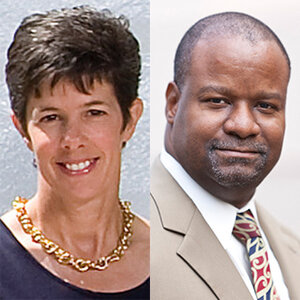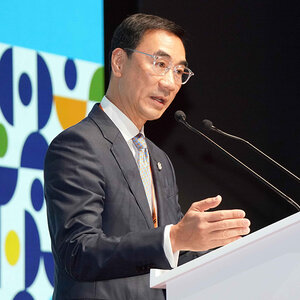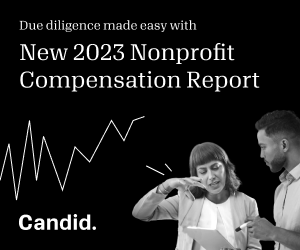Building trust with grantees with ‘radical humility’

Addressing today’s inequities and economic injustices is a daunting, yet increasingly urgent task. And while philanthropy is full of smart, mission-driven people, there is no denying that the field exists because of stark disparities in economic privilege, which creates distance between the philanthropic field and the injustices Dr. Martin Luther King, Jr. admonished us to deeply understand: “Philanthropy is commendable but it must not cause the philanthropist to overlook the circumstances of economic injustice which make philanthropy necessary.”
As a result, philanthropic culture change and mindset shifts can be challenging, even in a time when many are striving to build trust in philanthropy and philanthropic allyship. However, that doesn’t mean the field lacks strong examples of how to break through and make “moving at the speed of trust” more possible.
Grantee convenings hosted by philanthropies can be difficult to do in a meaningful way, but they present an opportunity to build trust and prioritize the values that can change how philanthropy learns about and centers economic injustice. The W. Clement and Jessie V. Stone Foundation has a long history of annual grantee convenings, but several years ago, we tried something new, which had the unexpected benefit of shifting our perspective on ideal philanthropic partnerships.
In 2017, Stone Foundation staff decided not to pre-determine the grantee convening topics or desired takeaways, but instead established a planning committee comprised of grantees representing each of our portfolios—early childhood, K-12, and youth development—and all geographies funded. We risked creating the chaos of the Tower of Babel, where each group spoke a different language, used different acronyms, and expressed different needs. But guided by a seasoned facilitator, we co-constructed with grantees an annual convening focused on equity, identifying issues that impacted people across age groups, organizations, and geographies.
While we went into the convenings focused on the differences among the portfolios, we quickly realized the similarities of the “circumstances of economic injustice” across portfolios and geographies: issues such as the disproportionate number of children of color being suspended and expelled from school (even preschoolers); the need for well-paid, well-supported teachers from early childhood through high school who look like the communities they serve; and the often-overlooked relationship between organizing and policy. The focus on equity spotlighted these shared challenges and common root causes, leading to rich discussions.
Those convenings allowed us as funders to hear what attributes were most valuable to our grantees in their day-to-day work of tackling inequities. Here is what we now know is essential to an ideal philanthropic partnership:
Radical humility: Money is only a part of any solution when the problem is as complex as intergenerational racialized oppression. Most funders understand this, but it is challenging to escape philanthropy’s origins of hierarchy and privilege. Follow-through requires commitment to moderating power and influence in order to avoid distorting or derailing the work being supported. The Stone Foundation is tackling the hard lesson that we need to maintain a learner disposition throughout our work. With a learner disposition, the foundation realized that we cannot limit our thinking about funding to a specific portfolio or project; instead, we need to explore the totality of what is needed for real social change. For example, in order for a policy grantee to authentically engage those most impacted by an issue, they might require support to build organizing capacity. Similarly, youth organizer grantees might need additional funds to build their policy muscle if they are going to achieve lasting systems change for youth.
Shared purpose: This is the “your shoulder to the organization’s wheel” concept. Philanthropy must hold and demonstrate a commitment to the aspirational goals that the partner organization is trying to accomplish and be transparent with how their success achieves shared goals. This demonstrates that “we're in this together.” When Partners in Schools succeeds in providing sustainable coaching and professional development support in a cohort of schools, that impact goes beyond the students of color in a school district. It addresses a broad social change goal of building a generation of youth who achieve their full potential and drive positive outcomes in major urban areas.
Getting proximate: Our convenings helped us all step out of the hierarchical paradigm and into a shared problem-solving frame where the foundation rolls up its sleeves and digs in with grantees as participant learners to support their problem solving from a side-by-side modus, rather than the typical “accountable partner” paradigm. In equity work, ceding power to those to whom your work should benefit is a necessary prerequisite to lasting change. Being physically present and in the community as a participant with communities of color is critical. Not only does it foster trust and produce more egalitarian interactions, but it unleashes the knowledge and power of those experiencing those challenges. A key principle of improvement is understanding that those closest to the work know most about how to meaningfully improve it.
Deep commitment: This is the only one of our tenets that actually has to do with funding. Organizations need philanthropic allies that care about the organizations themselves—and not just about the work that they do. This might seem like splitting hairs, but it can be a lifeline to organizations that have gone through tough times and need deeper relationships with funders to be fully heard and receive support. This could lead to increased organizational capacity, improved organizational health, and potentially longer engagements. That support could be financial support—or even non-financial support in the form of advice—for an area that the grantee needs to shore up, but that they might otherwise hesitate to share candidly out of fear that the funder may perceive it as a weakness that results in a decreased grant amount.
Beyond the content, the convening helped us, as funders, experience the lesson that equity isn’t only about “what” but also about “who” and “how”—which voices are heard and who is centered in decision making. With funders and grantees co-constructing the agenda, we came together as learners on the topic of racial equity. When you come to the table as a learner, you must be ready to listen, to be vulnerable, and to accept being wrong. In these meetings, we as funders released a level of control and trusted in our shared values with grantees to produce meaningful and challenging engagements.
In turn, grantees learned to trust that they could speak to us differently than they expected. They challenged some of our assumptions, disagreed with some of our interpretations, and offered radically different interpretations of their own. Grantees sometimes challenged us not to leapfrog over, or take for granted, the interim or small steps needed to reach big goals. At other times, they challenged us to examine the origins of how widely used terms were framed, encouraging us to instead seek the language that resonated with the communities served—for example, frames like “Latinx,” “post-pandemic,” and “post-George Floyd era.” Grantees shed the long-practiced skill of framing their language in the lens desired by the funder because showing weakness or being “off track” could be a threat to continued funding—the lifeblood of their work. This co-constructed space produced a mutual platform of trust between the funder and grantee.
Achieving and maintaining these culture changes and mindset shifts is neither easy nor a “one-and-done” kind of change, but rather a continuous process. For the Stone Foundation, the path is through co-constructed grantee convenings focused on equity, but the goal isn’t hosting a convening. Instead, as more foundations examine trust-based philanthropy, we must recognize that trust is a two-way street in which funders must not merely find a way to trust, but also a pathway to be trusted by grantees. To truly address the circumstances of economic injustice, philanthropy must step out of a hierarchical paradigm and into a shared problem-solving framework. None of the systemic inequities worth solving can be solved by one grantee or one funder.
Sara Slaughter is the executive director of the W. Clement and Jessie V. Stone Foundation based in Chicago, which provides fundings for K-12 education, early childhood education, and youth development in five major urban areas.
Derek Mitchell is the CEO of Partners in Schools Innovation, which works to transform teaching and learning in the most challenged U.S. public schools to improve educational opportunities for low-income students of color.







